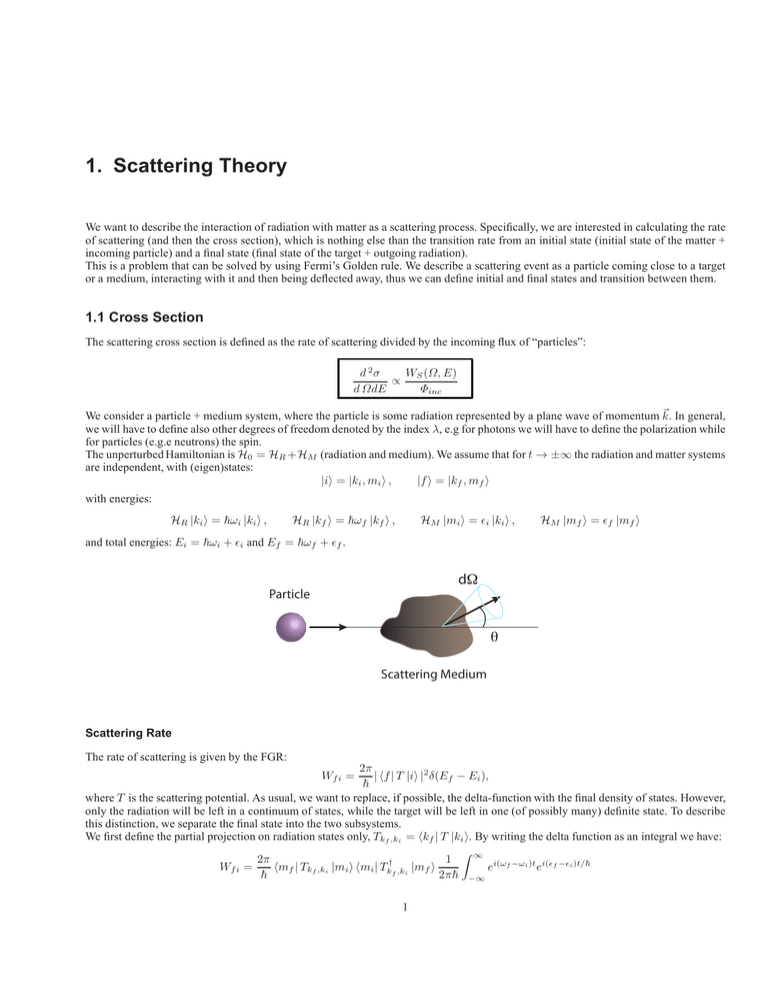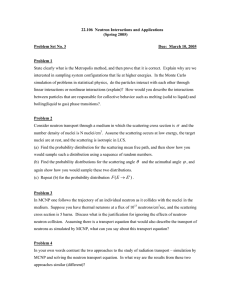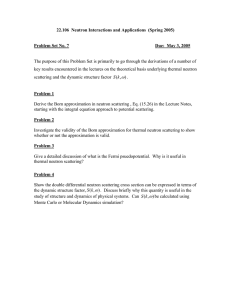1. Scattering Theory
advertisement

1. Scattering Theory We want to describe the interaction of radiation with matter as a scattering process. Specifically, we are interested in calculating the rate of scattering (and then the cross section), which is nothing else than the transition rate from an initial state (initial state of the matter + incoming particle) and a final state (final state of the target + outgoing radiation). This is a problem that can be solved by using Fermi’s Golden rule. We describe a scattering event as a particle coming close to a target or a medium, interacting with it and then being deflected away, thus we can define initial and final states and transition between them. 1.1 Cross Section The scattering cross section is defined as the rate of scattering divided by the incoming flux of “particles”: d 2σ WS (Ω, E) ∝ d ΩdE Φinc We consider a particle + medium system, where the particle is some radiation represented by a plane wave of momentum ~k. In general, we will have to define also other degrees of freedom denoted by the index λ, e.g for photons we will have to define the polarization while for particles (e.g.e neutrons) the spin. The unperturbed Hamiltonian is H0 = HR + HM (radiation and medium). We assume that for t → ±∞ the radiation and matter systems are independent, with (eigen)states: |ii = |ki , mi i , |f i = |kf , mf i with energies: HR |ki i = ~ωi |ki i , HR |kf i = ~ωf |kf i , HM |mi i = ǫi |ki i , HM |mf i = ǫf |mf i and total energies: Ei = ~ωi + ǫi and Ef = ~ωf + ǫf . dΩ Particle θ Scattering Medium Scattering Rate The rate of scattering is given by the FGR: 2π | hf | T |ii |2 δ(Ef − Ei ), ~ where T is the scattering potential. As usual, we want to replace, if possible, the delta-function with the final density of states. However, only the radiation will be left in a continuum of states, while the target will be left in one (of possibly many) definite state. To describe this distinction, we separate the final state into the two subsystems. We first define the partial projection on radiation states only, Tkf ,ki = hkf | T |ki i. By writing the delta function as an integral we have: Z ∞ 2π 1 † Wf i = hmf | Tkf ,ki |mi i hmi | Tkf ,ki |mf i ei(ωf −ωi )t ei(ǫf −ǫi )t/~ ~ 2π~ −∞ Wf i = 1 Now, since e−iHR t/~ |mi i = e−iǫi t/~ |mi i (and similarly for |mf i we can rewrite hmf | Tkf ,ki |mi i ei(ǫf −ǫi )t/~ = hmf | eiHR t/~ Tkf ,ki e−iHR t/~ |mi i = hmf | Tkf ,ki (t) |mi i and obtain a new expression for the rate as a correlation of “transition” events: Z ∞ 1 Wf i = 2 ei(ωf −ωi )t hmi | Tk†f ,ki (0) |mf i hmf | Tkf ,ki (t) |mi i ~ −∞ Final density of states The final density of states describe the available states for the radiation. As we assumed that the radiation is represented by plane waves (and assuming for convenience they are contained in a cavity of edge L), the final density of states is 3 ρ(kf )d kf = L 2π 3 kf2 dkf dΩ We can express this in terms of the energy, ρ(k)d3 k = ρ(E)dEdΩ. For example, for photons, which have k = E/~c we have ρ(E) = 2 L 2π 3 E2 =2 ~3 c3 L 2π 3 ωk2 ~c3 where the factor 2 takes into account the possible polarizations. For neutrons (or other particles such that E = ρ(E) = L 2π 3 k = ~2 L 2π ~2 k 2 2m ): 3 √ 2mE ~3 If the material target can be left in more than one final state, we sum over these final states f . Then the average rate is given by P W S = f Wf i ρ(E)dEdΩ (assuming that Wf i does not change very much in dΩ and dE). Incoming Flux The incoming flux is given by the number of scatterer per unit area and unit time, Φ = A#t . In the cavity considered, we can express the time as t = L/v, thus the flux is Φ = Lv3 . For photons, this is simply Φ = c/L3 , while for massive particles (neutrons) v = ~k/m, ~k yielding Φ = mL 3. 1.2 Thermal Neutron Scattering Using the scattering rate above and the incoming flux and density of state expression, we can find the cross section for thermal neutrons. From " # 3 L mkf ~ki (mL3 )2 kf ρ(E)/Φ = / = 2π ~2 mL3 (2π~)3 ki we obtain d 2σ W ρ(E) 1 =~ =~ d Ωdω Φ Φ ~2 2 Z D E E 1 mL3 kf ∞ iωf i t D † † eiωf i t Tif (0)Tf i (t) = e Tif (0)Tf i (t) , 2 2π 2π~ ki −∞ −∞ Z ∞ where h·i indicates an ensemble average at the given temperature. Now the eigenstates |ki,f i are plane waves, hr|ki = ψk (r) = eik·r /L3/2 . Then, defining Q = ki − kf the transition matrix element is Z Z 1 Tf i (t) = hkf | T (t) |ki i = d3 rψkf (r)∗ T (r, t)ψki (r) = 3 d3 reiQ·r T (r, t) L 3 3 L L and 1 Tf i (0) = 3 L † Z d3 re−iQ·r T (r, 0)† L3 2 Fermi Potential To first order, we can approximate T by V , the nuclear potential in the center of mass frame (of the neutron+nucleus). You might recall that the nuclear potential is a very strong (V0 ∼ 30MeV) and narrow (r0 ∼ 2fm) potential. These characteristics seem to preclude a perturbative approach, since the assumption of a weak interaction (compared to the unperturbed system energy) is not satisfied. Still, the fact that the potential is narrow means that the interaction only happens for a very short time. Thus, if we average over time, we expect a weak interaction. More precisely, the scattering interaction only depends on the so-called scattering length a, which is on the order a ∼ V0 r0 . If we keep a constant, different combinations of V, r will give the same scattering behavior. We can thus replace the strong nuclear potential with a weaker, pseudo-potential Ṽ0 , provided this has a much longer range r̃0 , such that a ∼ V0 r0 = V˜0 r̃0 . We can choose Ṽ0 , r̃0 so that the potential is weak (eV) but the range is still short compared to the wavelength of the incoming neutron, kr̃0 ≪ 1. Then, it is possible to replace the potential with a simple delta-function at the origin. 2π ~2 aδ(r) µ V (r) = We can also define the bound scattering length, b = the potential is µ mn a ≈ A+1 A , were mn is the neutron’s mass and A the nucleus mass number. Then 2π ~2 aδ(r) mn Note that b (interaction length or bound scattering length) is a function of the potential strength and range, which depend on the isotope from which the neutron is scattered off. ~2 Then to first order the transition matrix is Tf i = 2π mn b, or more generally, if there are many scatterers, each at a position rx (t), we have: V (r) = Tf i (t) = The scattering cross section becomes d 2σ 1 kf = d Ωdω 2π ki 2π ~2 X bx eiQ·rx (t) mn x ∞ Z e iωf i t −∞ * X bx by e −iQ·rx (0) iQ·ry (t) e x,y + Notice that since the collisions are spin-dependent, we should average over isotopes and spin states and replace bx by with bx by . Scattering Lengths Notice that b does not depend explicitly on position, although the position determines which isotope/spin we should consider. What is 2 2 2 bx by ? We have two contributions. For x = y this is b2 δx,y , while for x 6= y , it is b (1 − δx,y ). We then write bx by = (b2 − b )δx,y + b = 2 b2i + b2c which coherent scattering length bc = b and the incoherent scattering length b2i = b2 − b . If there are N scatterers, P defines the 2 2 we have bx by = N (bi + bc ). Structure Factors Using these definition, we arrive at a simplified expression: d 2σ kf 2 =N b SS (Q, ω) + b2c S(Q, ω) d Ωdω ki i where we used the self-dynamic structure factor 1 SS (Q, ω) = 2π Z ∞ −∞ eiωf i t * which simplifies to 1 X −iQ·rx (0) iQ·rx (t) e e N x + Z ∞ D E 1 eiωf i t e−iQ·r(0) eiQ·r(t) 2π −∞ if all nuclei are equivalent (same isotope), and the full dynamic structure factor * + Z ∞ 1 1 X −iQ·rx (0) iQ·ry (t) iωf i t S(Q, ω) = e e e 2π −∞ N x,y SS (Q, ω) = The structure factors depend only on the material properties. Thus they give information about the material when obtained from experiments. 3 MIT OpenCourseWare http://ocw.mit.edu 22.02 Introduction to Applied Nuclear Physics Spring 2012 For information about citing these materials or our Terms of Use, visit: http://ocw.mit.edu/terms.







